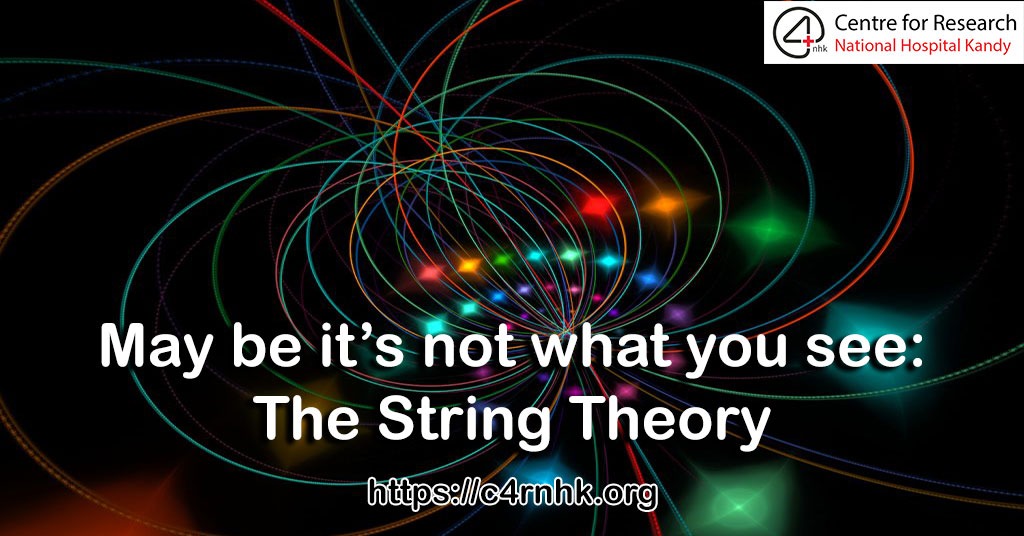What is the true nature of reality?
In order to find an answer, humans come developed various stories to explain the world itself. Scientists test those stories again and again and learn what needs to be kept for further discoveries and what to throw away. But the more we learn about the universe the more complicated and weird our theories become, like ‘String Theory,’ a famous and controversial story about the nature of everything.
Why did we come up with it?
As we all know, everything we see are made up of structures called molecules. Those molecules are made up of countless even smaller things – Atoms. Initially, we thought they were the final layer of reality until we smashed them together really hard and discovered elementary particles. Elementary particles are the smallest known building blocks of the universe. According to researches, they are zero-dimensional points that take up no space. They basically comprise two major types ‘matter particles (fermions)’ and ‘force particles (bosons).’ Quarks, leptons, antiquarks, and antileptons are considered as matter particles, while gauge bosons and the Higgs bosons are called force particles. But we can no longer look at them to identify as they are too small.
Principle of uncertainty
To see something, we need light, an electromagnetic wave. This wave hits the surface of the thing and gets reflected back from it into our eye. But the particles are so small that the electromagnetic waves we used to see are too big to touch them. Visible light just passes over them. We can try to solve this by creating electromagnetic waves with much smaller wavelengths. But shorter wavelengths mean more energy. So, when we touch a particle with a wave with lots of energy it alters the particle. So, we can’t measure elementary particles preciously.
This phenomenon is called ‘The Heisenberg Uncertainty Principle’ The basis of all quantum physics.
What does a particle look like then?
We don’t know. If we look really hard, we can see a blurry sphere of influence, but not the particles themselves. We just know they exist. But if so, how can we do any science with them. Humans invented a new story, a mathematical fiction ‘The story of the point particle.’ We decided that we would pretend that a particle is a point in space. An electron is a point with a specific electric charge and a certain mass. This way, physicists could define them and calculate all their interactions. This is called quantum field theory, and it solved lots of problems. All of the standard models of particle physics is built on it. And it predicts lots of things very well. Some quantum properties of an electron, for example, have been tested and accurate up to 0.0000000000002%. So while particles are not really points, but treating them as if they were we get a pretty good picture of the universe.
This idea actually helped for the advancement of science and led to a lot of real-world technology we use every day. Ex- Quantum Solvents, Hadron therapy, Maglev trains.
Where we place Gravity?
In quantum mechanics, all physical forces are carried by certain particles. But, there’s a huge problem when it comes to gravity. According to Ernestine’s theory of general relativity, gravity is not a force like the other in the universe. If the universe is a play particles are the actors, while the gravity is the stage. Gravity is a theory of geometry. It is the Geometry of space-time itself of distances, which we need to describe with absolute precision. But since there is no way to preciously measure things in the quantum world, the story of gravity doesn’t work with the story of quantum physics. When physicists tried to add gravity to the story by inventing a new particle their mathematics broke down.
From Points to Strings…
So, later smart scientists came up with a new story. They asked: what is more complicated than a point? A line or a string? String theory was born. What makes string theory more elegant, Is that it describes many different elementary particles s different modes of vibration of the string. Just like a violin string vibrating differently can give you many different notes; a string can give you different particles. Most importantly, this includes gravity. String theory promised to unify all fundamental forces of the universe. This caused enormous excitement and it became a possible theory of everything.
Much of the maths involving a consistent string theory do not work in our universe if we consider it as a 3 spatial (space) dimensional and one temporal (time) dimension. String theory needs 10 dimensions to work out. So, scientists did calculations in model universes. And then tried to get rid of the six additional dimensions and describe our own universe. But so far, nobody has succeeded and no prediction of string theory has proven experimentally. So, one could argue that string theory isn’t useful at all. Science is all about predictions and experiments. Physics is based on maths. 1+2 = 3, this is true no matter how you feel about it. And the maths in string theory does work out. That’s why string theory is still useful and gives us hope to find the reality of everything. String theory may point us in the right direction.
Watch this you tube video simply explaining The String Theory.

